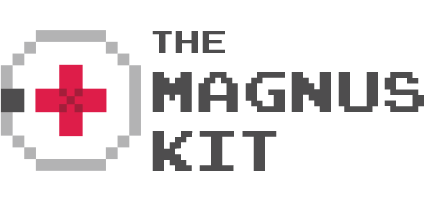Let’s Look At: Hyper Light Drifter
One of my favorite music genres is synthwave (just imagine if the 80s never stopped). I like the little imperfections that synths bring, as well as the art style that accompanies the music. Bright magentas, teals and cyans seem to leap off of album covers and landscapes. Ever since 2011’s Drive, the style has been popping up in other places, much to my delight like Far Cry 3’s expansion Blood Dragon. One of the more unexpected places was Hyper Light Drifter, a The Legend of Zelda inspired explora-thon.
Hyper Light Driver does have a story, but good luck figuring it out. Our main character basically appears out of nowhere, not terribly phased by the fact that they came through a dimensional portal into a new world. After a short rest and brief spout of coughing up blood, they’re off to explore their new world. There are several areas to explore, each of which with a theme to its monsters, like the wizard birds in the library-mountain, or the orc-samurai things in the ancient ruins.
Throughout each area you collect little rhombuses that unlock more areas, as well as some kind of giant lock that the main hub town is built around. Each area also has a final boss with unlocks one of the bigger locks. So, you keep moving towards unlocking this giant thing, but why? Does your character know what it is, or what it does? Will it send them home? Will it cure your mysterious illness? Fuck if I know, but it’s a good mystery that keeps you invested.
My absolute favorite part of this game is its design; visual, audio, and story-wise. I’m a sucker for both good pixel art and neon, and this game uses both to fantastic effect. The overall look of the game mirrors 16 bit SNES and Genesis games, but with modern polishes designers of the 90s could only dream about. The colors in the game are bright and vibrant which makes the world seem alien and wild. Everywhere you go, there are signs of previous civilizations and battles, empty except for the enemies and one or two friendly NPCs.
The whole package has a very solemn and haunting effect. There’s no dialogue in the game, so you never have to stop focusing on the art, which is a concession that few games are willing to make. The soundtrack to this game deserves praise as well. It’s ambient and stirring without intruding on gameplay or overriding any other part of the game. I would bet that the designers of this game are big synthwave fans. Each area has its own unique tracks and ambient sound, which keep every location feeling fresh. Lastly, the story design deserves recognition for its restraint. Much like The Legend of Zelda did, HLD plays its cards close to the vest; if you want to know about the story behind this place, you’re going to have to do some detective work and a good bit of guessing.
The combat in this game is very satisfying. Your character starts out with a laser sword and acquires several other kinds of weapons as you go including ranged weapons and bombs. Your sword has a nice three-hit combo which you can time to great effectiveness against groups of enemies. You can also get upgrades your weapons that increase their ammo count (in the case of ranged weapons) or give you alternate moves (in the case of your sword). You quickly acquire the ability to dash, which makes you feel like an action hero, zipping between enemies and cutting them down. Enemies in this game come in a variety of types, ranged and melee, and each enemy requires their own strategy. The orcs, for example, are relatively easy one-on-one, but it can be hard to dodge their attacks in groups. The joy of combat really shines in boss fights. Each boss has their own patterns, which you must study in an almost Dark Souls like fashion to beat them. Each of the bosses is difficult in their own way, which makes progressing past them feel as good as defeating some evil titan should.
Despite how much I love the story design, there are some drawbacks to the style. Because everything is kind of mysterious, it can be very easy to lose track of where you’re supposed to be going. There were some rhombuses that took me absolutely forever to find because even though I could see around where they were on the map, I couldn’t find out how to get to that particular point.
The game also has a 30FPS cap, which presents its own set of problems. Because the game runs slightly slower than most PC games do, the controls can feel a little fiddly. The game will not react to a very fast combination of buttons which can leave you on the wrong side of a bosses’ weapon swing, or down a pit. This keeps the combat from feeling graceful in the way that you would imagine it should feel like.
Worth Playing?
Yes.
If you’re at all interested in indie action games, exploration, or a mysterious and beautiful world you should definitely invest some time in Hyper Light Drifter. The neon alone sold it for me, but y’all might be tougher customers. Anybody who enjoyed the original Legend of Zelda game will enjoy this one, so I also recommend it to any diehard NES and SNES fans.
If you don’t share this article with everybody you know, you might be whisked away to another dimension. Just saying.
For a continual love letter to neon, don’t forget to follow TheMagnusKit on Facebook and Twitter.





